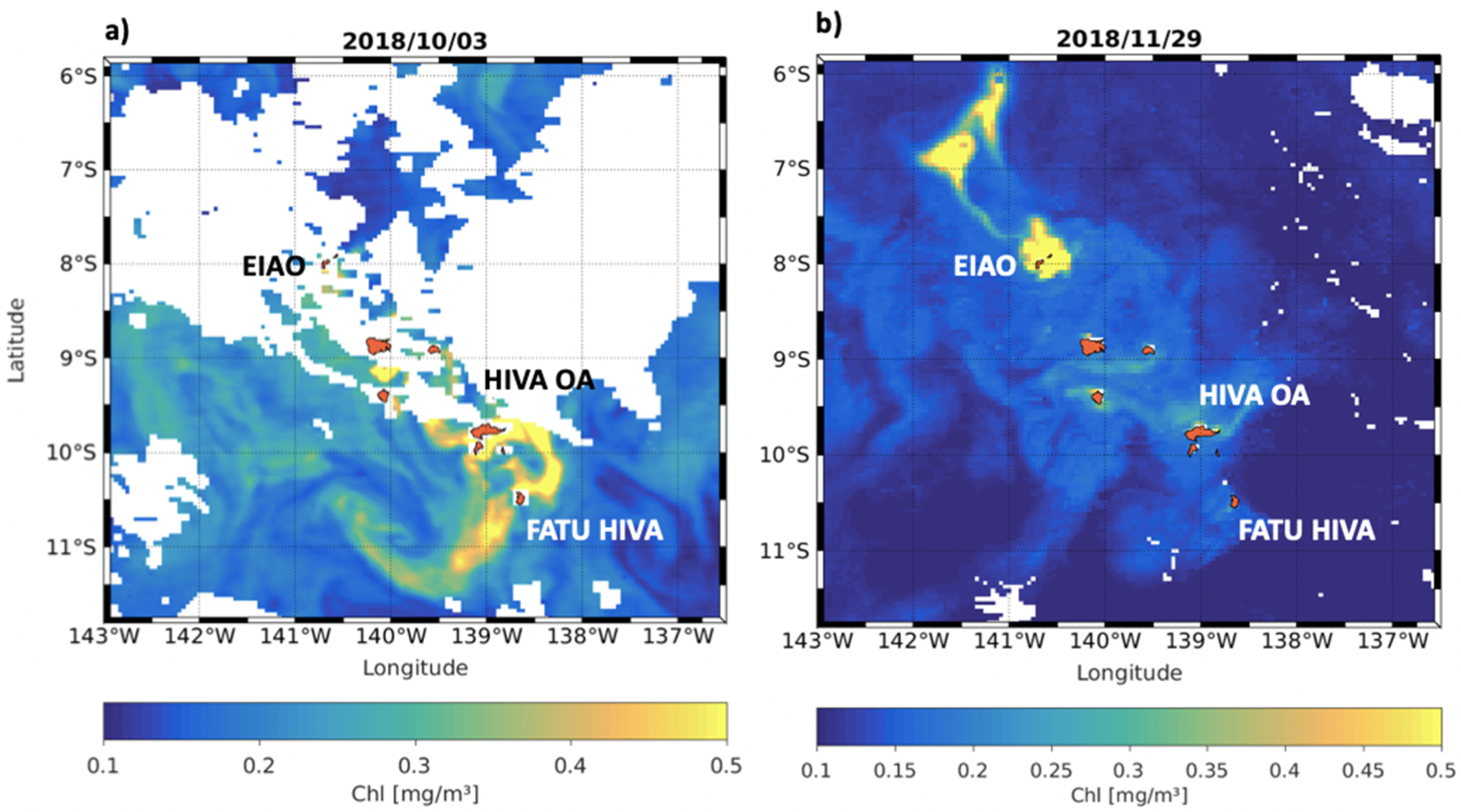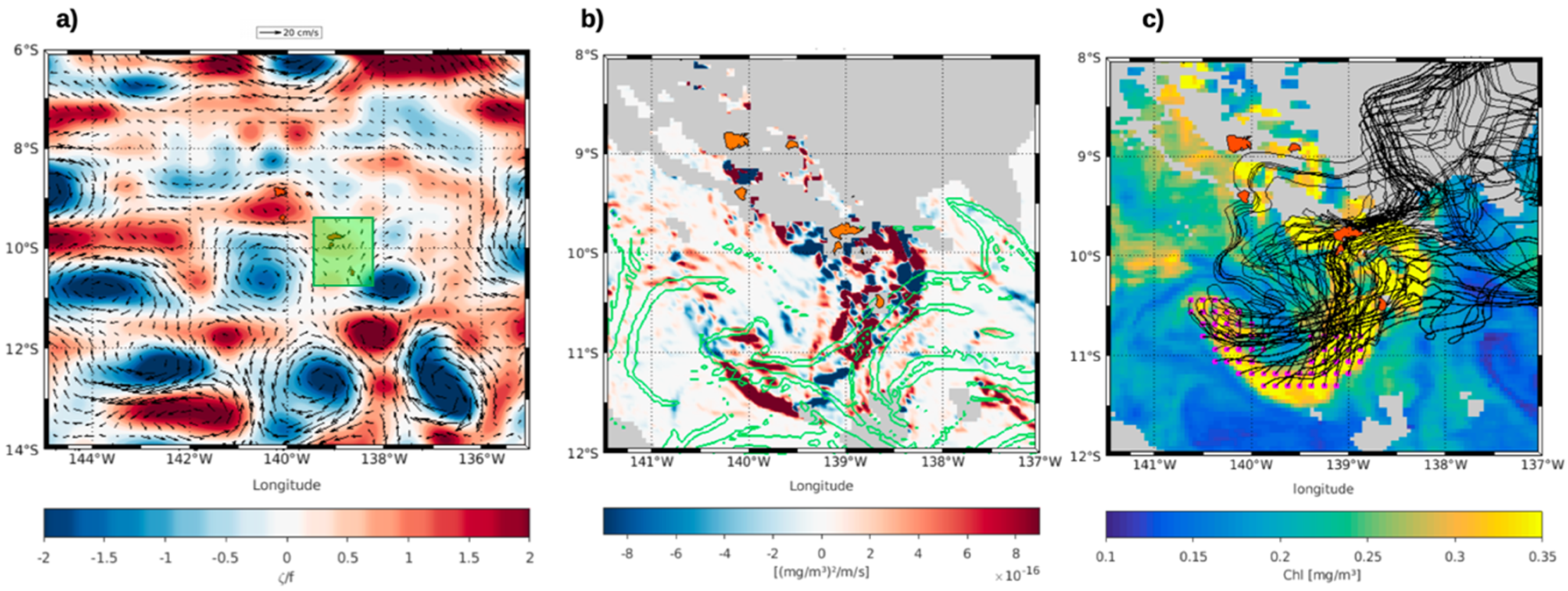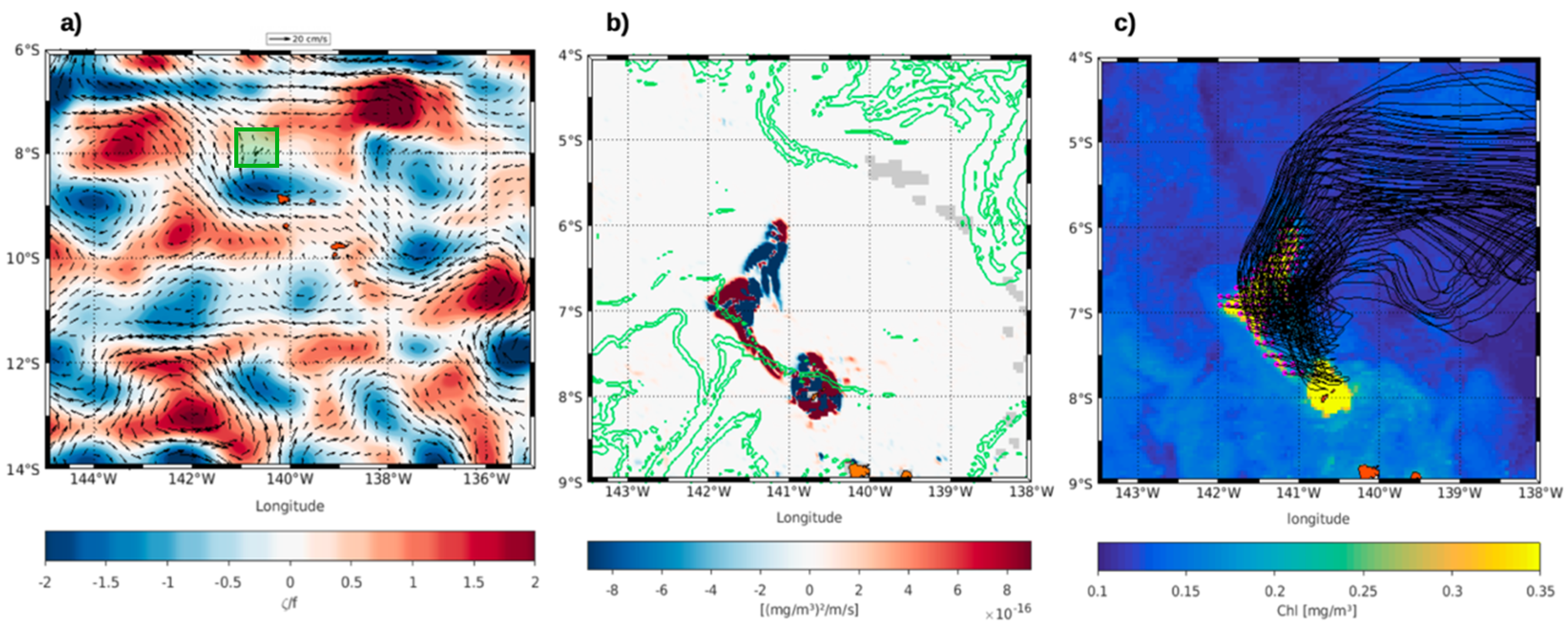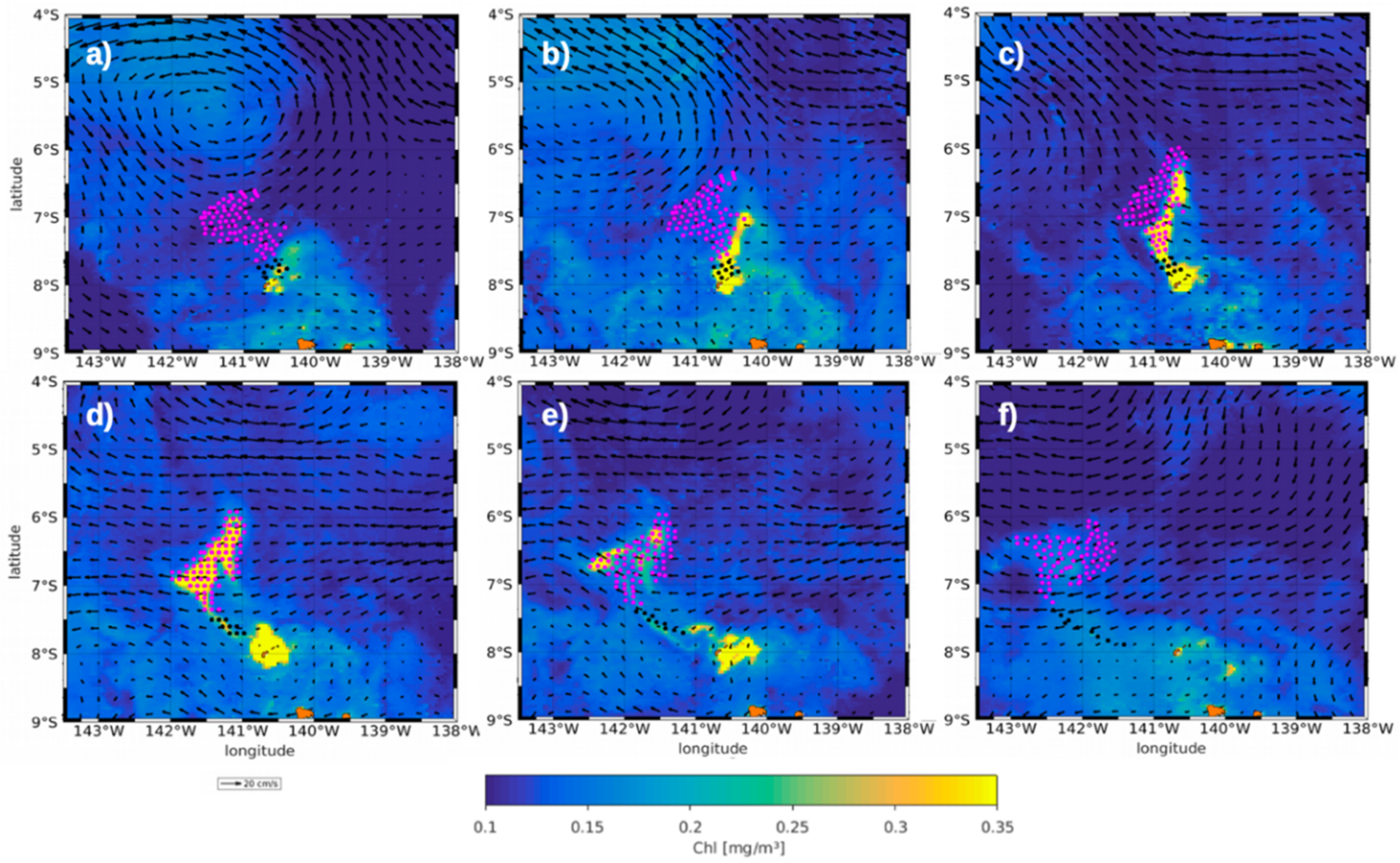Monitoring the Influence of the Mesoscale Ocean Dynamics on Phytoplanktonic Plumes around the Marquesas Islands Using Multi-Satellite Missions
Abstract
1. Introduction
2. Materials and Methods
2.1. Materials
2.1.1. In Situ Observations
2.1.2. Satellite Data
2.2. Methods
3. Results
3.1. Mesoscale Activity Influence on the Chl Plume South of the Marquesas
3.2. Convergence Fronts to Shape the Chl Plume North of the Marquesas
4. Discussion
5. Conclusions
Supplementary Materials
Author Contributions
Funding
Acknowledgments
Conflicts of Interest
References
- Doty, M.S.; Oguri, M. The Island Mass Effect. ICES J. Mar. Sci. 1956, 22, 33–37. [Google Scholar] [CrossRef]
- Coutis, P.F.; Middleton, J.H. Flow-topography interaction in the vicinity of an isolated, deep ocean island. Deep Sea Res. Part Oceanogr. Res. 1999, 46, 1633–1652. [Google Scholar] [CrossRef]
- Bucciarelli, E.; Blain, S.; Tréguer, P. Iron and Manganese in the wake of the Kerguelen Islands (Southern Ocean). Mar. Chem. 2001, 73, 21–36. [Google Scholar] [CrossRef]
- Leichter, J.; Shellenbarger, G.; Genovese, S. Breaking internal waves on a Florida (USA) coral reef: A plankton pump at work? Mar. Ecol. Prog. Ser. 1998, 166, 83–97. [Google Scholar] [CrossRef]
- Basterretxea, G.; Barton, E.D.; Tett, P.; Sangrà, P.; Navarro-Perez, E.; Aristegui, J. Eddy and deep chlorophyl maximum response to wind-shear in the lee of Gran Canaria. Deep Sea Res. Part I Oceanogr. Res. Pap. 2002, 49, 1087–1101. [Google Scholar] [CrossRef]
- Jiménez, B.; Sangrà, P.; Mason, E. A numerical study of the relative importance of wind and topographic forcing on oceanic eddy shedding by tall, deep water islands. Ocean Model. 2008, 22, 146–157. [Google Scholar] [CrossRef]
- Hasegawa, D.; Lewis, M.R.; Gangopadhyay, A. How islands cause phytoplankton to bloom in their wakes. Geophys. Res. Lett. 2009, 36. [Google Scholar] [CrossRef]
- Martinez, E.; Maamaatuaiahutapu, K. Island mass effect in the Marquesas Islands: Time variation. Geophys. Res. Lett. 2004, 31. [Google Scholar] [CrossRef]
- Signorini, S.R.; McClain, C.R.; Dandonneau, Y. Mixing and phytoplankton bloom in the wake of the Marquesas Islands. Geophys. Res. Lett. 1999, 26, 3121–3124. [Google Scholar] [CrossRef]
- Claustre, H.; Sciandra, A.; Vaulot, D. Introduction to the special section bio-optical and biogeochemical conditions in the South East Pacific in late 2004: The BIOSOPE program. Biogeosciences 2008, 5, 679–691. [Google Scholar] [CrossRef]
- Raimbault, P.; Garcia, N.; Cerutti, F. Distribution of inorganic and organic nutrients in the South Pacific Ocean & minus; evidence for long-term accumulation of organic matter in nitrogen-depleted waters. Biogeosciences 2008, 5, 281–298. [Google Scholar] [CrossRef]
- Raimbault, P.; Garcia, N. Evidence for efficient regenerated production and dinitrogen fixation in nitrogen-deficient waters of the South Pacific Ocean: Impact on new and export production estimates. Biogeosciences 2008, 5, 323–338. [Google Scholar] [CrossRef]
- Blain, S.; Bonnet, S.; Guieu, C. Dissolved iron distribution in the tropical and sub tropical South Eastern Pacific. Biogeosciences 2008, 5, 269–280. [Google Scholar] [CrossRef]
- Raapoto, H.; Martinez, E.; Petrenko, A.; Doglioli, A.M.; Maes, C. Modeling the Wake of the Marquesas Archipelago. J. Geophys. Res. Oceans 2018, 123, 1213–1228. [Google Scholar] [CrossRef]
- Martinez, E.; Rodier, M.; Pagano, M.; Sauzede, R. Plankton spatial variability within the Marquesas archipelago during the Pakaihi I te Moana cruise. J. Mar. Syst. (in review).
- Raapoto, H.; Martinez, E.; Petrenko, A.; Doglioli, A.; Gorgues, T.; Sauzède, R.; Maamaatuaiahutapu, K.; Maes, C.; Menkes, C.; Lefèvre, J. Role of Iron in the Marquesas Island Mass Effect. J. Geophys. Res. Oceans 2019, 124, 7781–7796. [Google Scholar] [CrossRef]
- Martinez, E.; Raapoto, H.; Maes, C.; Maamaatuaihutapu, K. Influence of Tropical Instability Waves on Phytoplankton Biomass near the Marquesas Islands. Remote Sens. 2018, 10, 640. [Google Scholar] [CrossRef]
- de Verneil, A.; Rousselet, L.; Doglioli, A.M.; Petrenko, A.A.; Moutin, T. The fate of a southwest Pacific bloom: Gauging the impact of submesoscale vs. mesoscale circulation on biological gradients in the subtropics. Biogeosciences 2017, 14, 3471–3486. [Google Scholar] [CrossRef]
- McEliece, R.; Hinz, S.; Guarini, J.-M.; Coston-Guarini, J. Evaluation of Nearshore and Offshore Water Quality Assessment Using UAV Multispectral Imagery. Remote Sens. 2020, 12, 2258. [Google Scholar] [CrossRef]
- Jing, Y.; Zhang, Y.; Hu, M.; Chu, Q.; Ma, R. MODIS-Satellite-Based Analysis of Long-Term Temporal-Spatial Dynamics and Drivers of Algal Blooms in a Plateau Lake Dianchi, China. Remote Sens. 2019, 11, 2582. [Google Scholar] [CrossRef]
- Buma, W.G.; Lee, S.-I. Evaluation of Sentinel-2 and Landsat 8 Images for Estimating Chlorophyll-a Concentrations in Lake Chad, Africa. Remote Sens. 2020, 12, 2437. [Google Scholar] [CrossRef]
- Rodier, M. MOANA-MATY 2018 Cruise, Alis R/V. 2018. Available online: https://doi.org/10.17600/18000580 (accessed on 1 June 2020).
- Ras, J.; Claustre, H.; Uitz, J. Spatial variability of phytoplankton pigment distributions in the Subtropical South Pacific Ocean: Comparison between in situ and predicted data. Biogeosciences 2008, 5, 353–369. [Google Scholar] [CrossRef]
- Maritorena, S.; d’Andon, O.H.F.; Mangin, A.; Siegel, D.A. Merged satellite ocean color data products using a bio-optical model: Characteristics, benefits and issues. Remote Sens. Environ. 2010, 114, 1791–1804. [Google Scholar] [CrossRef]
- Sudre, J.; Maes, C.; Garçon, V. On the global estimates of geostrophic and Ekman surface currents. Limnol. Oceanogr. Fluids Environ. 2013, 3, 1–20. [Google Scholar] [CrossRef]
- d’Ovidio, F.; De Monte, S.; Alvain, S.; Dandonneau, Y.; Levy, M. Fluid dynamical niches of phytoplankton types. Proc. Natl. Acad. Sci. USA 2010, 107, 18366–18370. [Google Scholar] [CrossRef] [PubMed]
- Levy, M.; Franks, P.; Smith, K. The role of submesoscale currents in structuring marine ecosystems. Nat. Commun. 2018, 9, 1–16. [Google Scholar] [CrossRef] [PubMed]
- d’Ovidio, F.; Della Penna, A.; Trull, T.W.; Nencioli, F.; Pujol, M.-I.; Rio, M.-H.; Park, Y.-H.; Cotté, C.; Zhou, M.; Blain, S. The biogeochemical structuring role of horizontal stirring: Lagrangian perspectives on iron delivery downstream of the Kerguelen Plateau. Biogeosciences 2015, 12, 5567–5581. [Google Scholar] [CrossRef]
- Hoskins, B.J. The Mathematical Theory of Frontogenesis. Annu. Rev. Fluid Mech. 1982, 14, 131–151. [Google Scholar] [CrossRef]
- Blanke, B.; Raynaud, S. Kinematics of the Pacific Equatorial Undercurrent: An Eulerian and Lagrangian Approach from GCM Results. J. Phys. Oceanogr. 1997, 27, 1038–1053. [Google Scholar] [CrossRef]
- Martinez, E.; Ganachaud, A.; Lefèvre, J.; Maamaatuaiahutapu, K. Central South Pacific thermocline water circulation from a high-resolution ocean model validated against satellite data: Seasonal variability and El Niño 1997–1998 influence. J. Geophys. Res. 2009, 114. [Google Scholar] [CrossRef]
- José, Y.S.; Penven, P.; Aumont, O.; Machu, E.; Moloney, C.L.; Shillington, F.; Maury, O. Suppressing and enhancing effects of mesoscale dynamics on biological production in the Mozambique Channel. J. Mar. Syst. 2016, 158, 129–139. [Google Scholar] [CrossRef]
- McGillicuddy, D.J.; Robinson, A.R.; Siegel, D.A.; Jannasch, H.W.; Johnson, R.; Dickey, T.D.; McNeil, J.; Michaels, A.F.; Knap, A.H. Influence of mesoscale eddies on new production in the Sargasso Sea. Nature 1998, 394, 263–266. [Google Scholar] [CrossRef]
- McGillicuddy, D.J.; Anderson, L.A.; Bates, N.R.; Bibby, T.; Buesseler, K.O.; Carlson, C.A.; Davis, C.S.; Ewart, C.; Falkowski, P.G.; Goldthwait, S.A.; et al. Eddy/wind interactions stimulate extraordinary mid-ocean plankton blooms. Science 2007, 316, 1021–1026. [Google Scholar] [CrossRef] [PubMed]
- Siegel, D.; Mcgillicuddy, D.; Fields, E. Mesoscale eddies, satellite altimetry, and new production in the Sargasso Sea. J. Geophys. Res. 1999, 104, 13359–13380. [Google Scholar] [CrossRef]
- McGillicuddy, D.J. Mechanisms of Physical-Biological-Biogeochemical Interaction at the Oceanic Mesoscale. Annu. Rev. Mar. Sci. 2016, 8, 125–159. [Google Scholar] [CrossRef]
- Auger, P.-A.; Gorgues, T.; Machu, E.; Aumont, O.; Brehmer, P. What drives the spatial variability of primary productivity and matter fluxes in the north-west African upwelling system? A modelling approach. Biogeosciences 2016, 13, 6419–6440. [Google Scholar] [CrossRef]
- Gorgues, T.; Menkes, C.; Aumont, O.; Vialard, J.; Dandonneau, Y.; Bopp, L. Biogeochemical impact of tropical instability waves in the equatorial Pacific. Geophys. Res. Lett. 2005, 32, L24615. [Google Scholar] [CrossRef]
- Messié, M.; Petrenko, A.; Doglioli, A.M.; Aldebert, C.; Martinez, E.; Koenig, G.; Bonnet, S.; Moutin, T. The Delayed Island Mass Effect: How Islands can Remotely Trigger Blooms in the Oligotrophic Ocean. Geophys. Res. Lett. 2020, 47, e2019GL085282. [Google Scholar] [CrossRef]
- Martinez, E.; Richards, K.J. Impact of spatio-temporal heterogeneities and lateral stirring and mixing on mid-water biotic interactions. J. Mar. Syst. 2010, 82, 122–134. [Google Scholar] [CrossRef]




© 2020 by the authors. Licensee MDPI, Basel, Switzerland. This article is an open access article distributed under the terms and conditions of the Creative Commons Attribution (CC BY) license (http://creativecommons.org/licenses/by/4.0/).
Share and Cite
Cassianides, A.; Martinez, E.; Maes, C.; Carton, X.; Gorgues, T. Monitoring the Influence of the Mesoscale Ocean Dynamics on Phytoplanktonic Plumes around the Marquesas Islands Using Multi-Satellite Missions. Remote Sens. 2020, 12, 2520. https://doi.org/10.3390/rs12162520
Cassianides A, Martinez E, Maes C, Carton X, Gorgues T. Monitoring the Influence of the Mesoscale Ocean Dynamics on Phytoplanktonic Plumes around the Marquesas Islands Using Multi-Satellite Missions. Remote Sensing. 2020; 12(16):2520. https://doi.org/10.3390/rs12162520
Chicago/Turabian StyleCassianides, Angelina, Elodie Martinez, Christophe Maes, Xavier Carton, and Thomas Gorgues. 2020. "Monitoring the Influence of the Mesoscale Ocean Dynamics on Phytoplanktonic Plumes around the Marquesas Islands Using Multi-Satellite Missions" Remote Sensing 12, no. 16: 2520. https://doi.org/10.3390/rs12162520
APA StyleCassianides, A., Martinez, E., Maes, C., Carton, X., & Gorgues, T. (2020). Monitoring the Influence of the Mesoscale Ocean Dynamics on Phytoplanktonic Plumes around the Marquesas Islands Using Multi-Satellite Missions. Remote Sensing, 12(16), 2520. https://doi.org/10.3390/rs12162520








